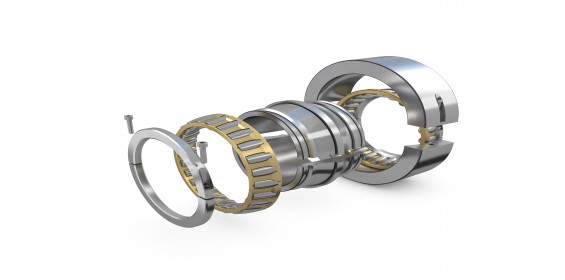Conveying the benefits of split spherical roller bearings
Published: 24 October, 2019
When it was first introduced a little over a century ago, the heavy-duty belt conveyor revolutionised the mining, quarrying and cement industries. Maintaining this machinery, however, has always been a slow, expensive and dangerous task. PWE reports.
Despite significant reductions, the number of injuries and fatalities that occur in the mining industry each year remains high. Many of these happen when maintenance and repair work is being carried out. Industry studies have found that 43% of all accidents and 24% of all fatalities occur during maintenance work on conveyors. Partly because couplings and gearboxes on these machines need to be hoisted during repair, which creates certain risks.
Indeed, in the mining, mineral processing and cement industries, conveyors are by far the most troublesome machinery to keep running efficiently. One problem is grease consumption; conveyors typically use standard open-pulley bearings, which require large amounts of grease to purge any contamination. Furthermore, open bearings have a relatively short service life and therefore normally do not last as long as the pulley lagging itself.
The premature failure of bearings entails their frequent repair and replacement. To compound the issue, this is time-consuming, costly and – as we have seen – dangerous work. Since bearings are often situated in difficult to access locations, it can take up to 24 hours to replace them. Preventing the contamination of conveyor bearings, reducing the amount of lubrication they need and speeding-up repair times are therefore crucial challenges for the mining, mineral processing and cement industries.
Clive Jennings, SKF Cooper Split Bearings product manager at SKF told PWE that in response to these challenges, the SKF Cooper split spherical roller bearing has been developed. These are designed to counteract the contamination that so frequently causes open pulley bearings to fail, to extend the service life of the bearing and to reduce costly downtime.
The split design of the bearing enables its in-situ replacement in machinery, thereby reducing downtime, maintenance costs and risks to worker safety. The sealed variant greatly reduces the need for lubrication, by providing effective protection against contamination.
The bearing comprises inner and outer rings, a cage and rollers, an outer shroud and two inner clamp rings, and screws to bolt the shrouds and clamp the rings together. The design of the rings in particular serves to enhance the performance of the bearing and increase its service life. Both the inner and the outer rings are wire cut to minimise discontinuities, ensuring superior clamping and the accurate alignment of the two halves of the ring. The interlocking outer race and shroud joints not only ensure the good alignment of the two halves, they also reduce risk of damage at the splits during operation. The wire cut angular inner race joints further ensure a smooth roller path.
Moreover, using wire cutting as a splitting technique, rather than employing alternative methods also means that the risk for fretting corrosion with the shaft is minimised. Finally, the steel clamp rings allow permissible axial loads (shaft clamping) of around 50–100% greater than comparable split spherical roller bearings and they are even quieter when in operation.
For customers looking for bearings designed to be easily replaced in situ, with little disturbance to the shaft alignment or driveline, the use of SKF Cooper split spherical roller is claimed by Jennings to reduce mean time to repair (MTTR) by as much as 70%.
The main use of the SKF Cooper split spherical roller bearing is in the trapped bearing position of the machine. Here, the replacement of a bearing with a standard (non-split) version would require the removal (hoisting) of the gearbox and drive coupling. With the SKF Cooper split bearing, the number of actions required to replace a bearing in the trapped position is reduced from seventeen to just eight.
For instance, use of the bearing eliminates the need to make any changes to the alignment of the shaft or the driveline. There is no need to dismount the drive coupling or cantilevered drive, reducing the amount of equipment, such as cranes and alignment tools, that need to be rented to complete the job.
Moving the conveyor belt to access the pulley, and moving the pulley and gearbox, can be very dangerous operations to carry-out since these components are often heavy and elevated above ground. This increases the risk to maintenance personnel. By contrast, the in-situ replacement with a split bearing only requires the slight raising of the shaft and little or no disturbance of the drive coupling or gearbox. This greatly reduces the exposure of workers to safety hazards.
As a further benefit, the use of a sealed split bearing also greatly reduces the need for lubrication – approximately 90 to 95% less grease can be used – resulting in reduced costs, safety risks and environmental impact.
***************
Sequence of procedures for replacing a bearing in the trapped position
Standard bearing
• Safety lockout/tagout
• Block machine (pulley) from rotation
• Block and move belt to access pulley
• Disconnect gearbox coupling from motor
• Disconnect gearbox coupling from machine
• Remove coupling from machine
• Lift and remove gearbox
• Remove split block housing cap
• Lift and support machine shaft
• Remove and replace bearing
• Replace housing cap
• Reposition gearbox
• Connect gearbox to machine
• Connect gearbox to motor
• Check alignment of motor to gearbox
• Remove machine blocking
• Remove safety lockout/tagout.
Split bearing
• Safety lockout/tagout
• Block machine (pulley) from rotation
• Remove split block housing cap
• Lift and support machine shaft
• Remove and replace bearing
• Replace housing cap
• Remove machine blocking
• Remove safety lockout/tagout.
*****************







